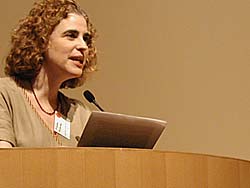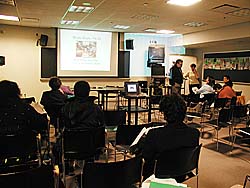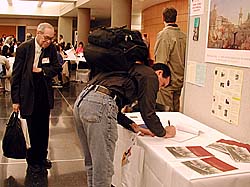First NYC Teachers Conference
Keynote
To kick off the conference, The Gotham Center's Associate Director Suzanne Wasserman welcomed the participants, spent a few moments outlining the mission of the Gotham Center's teaching project, and introduced the conference coordinators, Julie Maurer and Cynthia Copeland. Maurer and Copeland discuss some logistics for the day and then turned the stage over to Mike Wallace, Director of the Gotham Center, who delivered a lively keynote address on the importance of teachers and the opportunities and challenges that make education in New York City a unique undertaking.
Presentations
Maps and Stories: Giving a Sense of Place to Cyberspace: A Website Project at the Fieldston School
(7th to 12th grade)
Mapsites allows teachers to turn their classroom into a collaborative writing workshop and a class newspaper in which the teacher is editor-in-chief. This demonstration of Mapsites will explore educational possibilities opened up when students' writing is posted on an on-line map. Mapsites can be used to stimulate student writing, ranging from personal essays and creative writing exercises to more academic material like history or social studies papers.
Thomas Beller, President, Mapsites.net, Mrbellersneighborhood.com
Robert McClintock, Director, Institute for Learning Technology at Teachers College, Columbia University
Andrew Meyers, Teacher, Fieldston School
The Origins Project: Research, Writing, and Drama in the History Curriculum
(6 -12 grades)
This session presents the Origins Project, a collaboration between the Lower East Side Tenement Museum and City Lights Youth Theatre, where NYC teens spend five weeks researching, writing and performing a play based on the history of the Lower East Side. Session participants will take part in simple exercises that illustrate Origins techniques. Lynda Kennedy, Education Coordinator at the Lower East Side's Tenement Museum, will screen a video clip of the work created by the Origins Project and hand out a bibliography that encourages the use of drama and writing for the development of an engaging, interdisciplinary history program.
New York City on the Box (7th to 12th grade)
Education programs at the Museum of Television and Radio use television and radio as a catalyst for learning and as a means for helping teachers meet curriculum standards. The program "New York on the Box" explores the changing images of New York City on television. How have fictional representations of "The Big Apple" changed over time and how do they reflect reality? Suzy Phillips, Education Coordinator at the Museum, will critically examine New York City as it appears on television and consider the importance of setting and location in narrative.
NYC Multimedia Technology Projects: Lower East Side (4th to 6th grade)
American Gateways and Henry Street Settlement work with students in CSD1 to study local architecture and NYC history. Several multimedia projects centering around this theme will be displayed and discussed. Software programs used include PowerPoint, Excel, Word, HyperStudio, and iMovie.
David Bellel, Project Director, American Gateways, Community School District 1
Janet Chasin, American Gateways Staff Developer, CSD 1
Mindy Gluck, Classroom Teacher, PS 20 and Henry Street Settlement
New York's Underground History (K-12)
What better way to supplement your classroom curriculum than with a pile of trash! Archaeological excavations in New York City have produced a veritable treasure trove of artifacts, many of which are housed in the South Street Seaport Museum's collections. In this hands-on, interactive workshop, Hilary Eddy, Archaeology Educator at the Museum, will examine objects dating back to the 17th century. Working in small groups, participants will discuss lessons appropriate to their grade level that focus on interpreting the past through material remains.
Tour of the Old York Library
Wendy Durst Kreeger, President of the Old York Foundation, takes participants on a tour of the Library's Seymour B. Durst collection, which documents the political, social, commercial and economic development of the City of New York, with particular emphasis on the 19th century. The collection includes books, rare reports with extensive maps, early NYC newspapers, original photographs, postcards, playbills, pamphlets, periodicals, ephemera and a wealth of visual materials. The library services a wide range of users and makes its holdings known through its website.
City of Neighborhoods: Bridging School and Community: An Overview of Experiences (K-12)
Launched in 1991, "A City of Neighborhoods" is a joint project of Cooper-Hewitt, National Design Museum and Learning by Design: NY Program of the New York Foundation for Architecture, Inc. Over the course of ten years, it has provided hundreds of educators techniques for using the community as the focus for a series of lectures and workshops in which participants learn how to use community resources to enrich school curricula. This presentation will utilize slides, hands-on activities and primary resources such as maps and historic photographs.
Monica Hampton, Program Coordinator for Schools, Cooper-Hewitt, National Design Museum
Catherine Teegarden, Program Director, Learning By Design: NY (New York Foundation for Architecture)
Life in New Amsterdam (2nd to 4th grade)
The origins of New York City, one of the most important financial capitals of the world, can be traced back to its founding as a Dutch trading post in the 17th century. Elizabeth Byrne and Bonnie Levine will conduct a workshop on classroom and museum strategies for teaching this state-mandated subject. Discussion will include creating a thematic curriculum and incorporating different disciplines such as economics, social studies, and English language arts into the study of New Amsterdam. This workshop will model teaching from primary sources, including maps, documents and artifacts, and also explore how teachers can create their own touch collection for object study in the classroom.
Elizabeth Byrne, Coordinator of Elementary School Programs, The New-York Historical Society
Bonnie Levine, Teacher, Corlears School
Using Photography to Learn About Immigration (7th to 12th grade)
Imagine arriving new to this country — what do you see? In ICP's Community Program at the Adolph S. Ochs School, 7th and 8th grade students are asked to express through photographs what it might have been like to be an immigrant to New York City in the 1900s. They learn to study, discuss, and create photographs that help them to picture history. This presentation will review the ICP photography projects on immigration through a slide presentation and discussion. Then, ICP educators will lead a hands-on photographic activity to provide a sense of how to use photography in the classroom.
Cynthia Way, Coordinator, Community Programs, International Center of Photography
Nancy Wechter, Photographer/Instructor
Karen Lindsay, Photographer/Instructor
Erin Fallon, Community Programs Assistant, ICP
Fire in the Sky: Using Technology to Bring History Alive (5 -8 grades)
In this session, Chris Czajka, Associate Director of the National Teacher Training Institute at Thirteen/WNET, examines historic events from the early 20th c. via use of video and the Internet. Participants will have a hands-on experience that will introduce them to conditions facing factory workers in the early 1900s and learn strategies for incorporating technology into history instruction.
Oral History As Drama: A Catalyst for Learning (7th to 12th grade)
This workshop will demonstrate the richness of oral history as a primary source for exploring history, cultural issues and immigration. We will present strategies for using oral history as theater, featuring immigration stories from Coming Through: Ellis Island to JFK, a play based on oral histories of those who came to America in the 1920s and new arrivals who come through JFK today. This interactive workshop will explore methods of eliciting oral histories from students and accessing NYC's vast oral history resources.
David Kener, Director of Education, The American Place Theatre
Lisa Richards, Associate Director of Education, The American Place Theatre
Peter Ruocco, Education Associate, The American Place Theatre
Heaven Will Protect the Working Girl: Immigrant Women at the Turn of the Century (High School)
This interdisciplinary workshop will focus on the themes of immigration, labor, and social reform in NYC. Participants will engage in hands-on activities using student-centered, inquiry-based teaching strategies and ASHP curriculum resources. Using literature, images, and primary documents that reflect different points of view, workshop lessons aim to strengthen students — writing, critical thinking and visual literacy skills.
Eliza Fabillar, Co-Director of Education, American Social History Project, Center for Media and Learning, The Graduate Center (CUNY)
Raj Nanda, Teacher, Martin Luther King JHS
Using Art to Understand History: The Ashcan Artists, the Muckrakers, and the Progressive Era (8th grade)
Ann Marie Chinnery will present two lessons involving primary sources from a unit on the Progressive Era. She will use lesson plans, worksheet samples, a resource list and Internet material. Primary sources include excerpts from the writings of Muckrakers and paintings by the Ashcan artists. Professor Snyder will discuss his work as co-curator of the Smithsonian exhibit, "Metropolitan Lives: The Ashcan Artists and Their New York." In addition, he'll show his short documentary film, "City Kids Meet Ashcan Art," which examines the ways in which city children's every day experiences can direct their inquires about art.
Ann Marie Chinnery, Teacher, Mott Hall School
Robert W. Snyder, Associate Professor, Rutgers University - Newark
The Community as Classroom (2nd to 7th grade)
New York City's natural and built environments — its buildings and open spaces — are immediately accessible primary sources for the teaching of history. They can also enhance the teaching of the other traditional disciplines, bringing new perspectives and energy to standards-based instruction. Many civic and community-based organizations work with local schools to bring an understanding of neighborhood history and architecture to both teachers and students. This panel will introduce some of these organizations and their teaching methods to primary and elementary school teachers.
Franny Eberhart, Board of Directors, Historic Districts Council; Editor, Community as Classroom
Carlo Lamagna, Chair, Department of Art and Art Professions, NYU School of Education and Landmark West! Board of Directors
Jane Cowan, Architectural Educator and Preservation Consultant
Slavery and NYC: Complicity and Resistance (7-12 grades)
New York City was both a center of abolitionist advocacy and of financing for slavery and the slave trade. Alan Singer, Professor of Curriculum and Teaching, and others from Hofstra University's New Teachers Network, will present a curriculum with classroom activities that examine the city's complex historical relationship with slavery. Lessons focus on slave narratives, abolitionist writings, contemporary newspaper reports and collaboration by government officials with the secessionist state. Includes exhibits from a middle school "Museum of Slavery."
Giving Voice to a Community: NYC History (High School)
This project is designed to give students experience in finding and interpreting multiple source. Sources will include census data, historic maps and photos, surveys and oral histories. Students, working in groups, choose a census tract and do a detailed study of that area over the last one hundred years. Students will discuss their work as part of the presentation.
Bayard Faithfull, Teacher, Beacon School
Kevin Jacobs, Teacher, Beacon School
Students from the Beacon School
Using NYC Museums and Gallery Resources to Teach Art History (8th to 12th grade)
NYC boasts the largest selection of museums, galleries and cultural institutions in the world. How can teachers expose their students to the visual arts and use the resources that these institutions have to offer in their curriculum? In this workshop, Roy Reid, a teacher at the Urban Academy, with Laboratory High School, discusses some of the methods used inside and outside the classroom to teach art and art history. We will also look at what different galleries and museums offer to teachers to enhance their students — art experience.
New York History Day Presentation (6th to 12th grade)
Inspired by the need for new methods of interdisciplinary teaching and non-traditional ways of reinforcing existing curricula, NYC History Day invites students and teachers to participate in a year-long process of conducting research on a given theme. In this presentation by Robert Forloney, Learning Programs Coordinator at the Museum of the City of New York, teachers will learn tools and techniques in order to become facilitators between primary sources and their students.
Creating An Integrated Curriculum Using the Theme of New York City (K-12)
Harriet Pitts of the City College of New York (CUNY) discusses the creation of an integrated curriculum using the theme of New York City. In tabletop style, she and a team of graduate students at Foundations of Reading will demonstrate how to develop and use thematic units focusing on New York City. Teachers, in turn, work together to develop and implement the theme within their classrooms.
Using Text and Video in Historical Frameworks (Middle School)
Stephen Simons of The Carroll Gardens Community School leads a roundtable discussion on student engagement in historical literature and in videos. ELA standards will be pinpointed as well as child-centered "readability" and "viewability."
Using Schools and Community as Historical and Writing Resources (9 -12 grades)
Through investigating school and local community, high school students are engaged in meaningful ways with history and writing. Local neighborhood research gives students control over their own education, experience with document-based learning, and practice in responding to questions in writing.
Victoria Missick, Educator
Angela Miller, Teacher, Benjamin Bannecker Academy
Designing A High School Curriculum for the Preservation Arts (High School)
This panel discussion will focus on prototypical lessons that were developed through the methodology of Historic Preservation and Benchmark Structures to teach students at the High School of Arts and Business. Ruth Baker and four high school teachers will discuss this pilot preservation arts curriculum. The discussion will address the NJIT Center model of professional development and the Center Benchmark approach. There will be a short video to show the teachers and students in the field.
Ruth Baker, Associate Director, New Jersey Institute of Technology, Center for Architecture and Building Science Research
Bryan Serra, Art, High School for Arts and Business
Lynda Aron, English, High School for Arts and Business
David Moyal, History, High School for Arts and Business
Kieran McGuire, Science, High School for Arts and Business
Best Practices: A Roundtable Discussion With Teachers Using Primary Resources in the Classroom (4th to 12th grade)
Experienced teachers discuss a variety of approaches to using primary documents. Sources such as literature, poetry, maps, music, and field trips will be examined.
Monique Bertolotti, 4th grade, Grace Lutheran School
Thomas Guarino, 4th grade, Community School
Leonard Geller, 7th grade, Teacher, IS 25
Mariann DeAngelis, 11-12th grades, History Chairperson, Dominican Academy
Andrew Taylor, 7th grade, Chair, Middle School History Department, Horace Mann School
Karen Phillips, Executive Director, Family Learning Project, PS 117
Moderator: Brenda Parnes, Ph.D, CA, Regional Advisory Officer, Region 1
Harbor History: School Programs from Two New York Maritime Collections (6th to 12 grade)
David Allen, Director of Education at the National Maritime Historical Society, will present "War of the Rose: A Royal Navy Warship During the American Revolution." The program is based on primary sources such as excerpts from the captain's logbook, letters to and from the captain and his superiors, and letters written by American soldiers in New York who actually engaged the Rose in battle. Diane Matyas, Director of Education at the Noble Maritime Collection, will discuss how her institution uses a theatrical narrative approach to teach the history of the New York harbor. Her program uses stories, songs and crafts of the maritime experience.
An Interdisciplinary Study of the Lenape Indians (2-6 grades)
An interactive program that offers elementary school teacher activities and techniques to implement the cultural study of NYC's first inhabitants, the Lenape, into various content areas. From the science of cooking to the art of pictographs, teachers will be given the opportunity to explore the early life of the Lenapes. A timeline will be used to guide this educational journey. Reproducible handouts will be distributed.-
Christa McDonald, Director of Environmental Education, High Rock Park Environmental Education Center
Joann Assante, Environmental Educator, High Rock Park Environmental Education Center


















